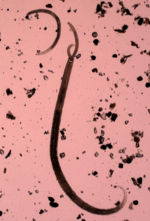Difference between revisions of "Nematode Structure and Function"
| Line 8: | Line 8: | ||
Morphological differences in the cuticle are regularly used to identify different species of nematodes, though the functions of these are not all completely understood. | Morphological differences in the cuticle are regularly used to identify different species of nematodes, though the functions of these are not all completely understood. | ||
*'''Annulations''' - Transverse lines in cuticle, possibly used as anchoring points in locomotion | *'''Annulations''' - Transverse lines in cuticle, possibly used as anchoring points in locomotion | ||
| − | *'''Longitudinal Ridges''' - also known as 'synlophe', seen in some [[ | + | *'''Longitudinal Ridges''' - also known as 'synlophe', seen in some [[Trichostrongylidae]] species. |
==Locomotion== | ==Locomotion== | ||
Revision as of 20:00, 4 August 2010
| This article is still under construction. |
Overview
The structure of a nematode is intimately related to its function and its life cycle. Although there are common traits throughout the phylum there is also great diversity allowing each species to occupy a niche in which it may thrive.
Body Structure
The nematode body is cylindrical, elongated and smooth with no limbs protruding, such as is seen in the common garden worm though generally on a smaller scale. The body is contained within a tough elastic cuticle which in many species forms elaborate structures useful for identification. The presence of a cuticle is similar to the structure of arthropods, however unlike them the nematode cuticle is not chitinous but is comprised mainly of collagens. The cuticle is non-living, produced by cells of the epidermis in most of the worm, allowing it to grown between moults of the worm without the need for shedding, although this does occur a number of times during the development of most worms. It is permeable to allow ions and water to pass through and therefore plays a key role in maintaining the hydrostatic pressure, which in most nematodes is relatively high inside the worm. The cuticle also acts as an anchoring point during locomotion as a skeleton does in mammalian species.
Morphological differences in the cuticle are regularly used to identify different species of nematodes, though the functions of these are not all completely understood.
- Annulations - Transverse lines in cuticle, possibly used as anchoring points in locomotion
- Longitudinal Ridges - also known as 'synlophe', seen in some Trichostrongylidae species.
Locomotion
Locomotion in nematodes involves somatic muscles that are present below the cuticle. They are obliquely striate unlike mammalian muscles and have dense bodies as opposed to Z disks.
Nervous System
Knowledge of the nervous system employed by nematodes has enabled the development of many anti-parasitic drugs as they work to disrupt this system. There is a neural ring around the pharynx of the nematode containing 4 ganglia which communicate distally to the body of the nematode to co-ordinate movement.
Feeding and Digestion
Reproduction
Recognition Features
- A unique feature of the nematodes is that the fluid in the body cavity is maintained under high pressure (this is why nematodes often burst after collection)
- They therefore have a tough elastic cuticle which often forms elaborate structures useful for identification
- A muscular pharynx is needed to pump food into the intestine
- The shape of the pharynx is characteristic in some groups
- There is a nerve ring around the pharynx and four longitudinal nerves with ganglia that co-ordinate movement (many anthelmintics act by disrupting neuromuscular co-ordination)
- The sexes are separate:
- the female tail generally ends in a blunt point
- males usually have two chitinous rods that can be protruded through the cloaca to hold the female - these are called spicules and, being chitinous, are easily seen under the microscope. As these differ in shape and size between species, they are very useful in identification
- The bursate nematodes are characterised by a large expansion of the cuticle of the male tail to form a clasping organ (the bursa)
- Other modifications of the cuticle on both male and female nematodes useful for identification include:
- alae (wing-like protrusions)
- vesicles (swellings around the whole circumference of the body)
- The heads of some nematodes have structures such as:
- leaf-like lips around the mouth (the leaf-crown)
- a buccal cavity
- teeth or cutting plates
Feeding Habits
- Many intestinal nematodes are closely applied to the mucosal surface
- Some swallow ingesta and/or host secretions.
- Others suck a plug of mucosa into the buccal cavity (plug feeders), leaving a circular ulcer
- Yet others bury their heads deep into the mucosa and suck blood
